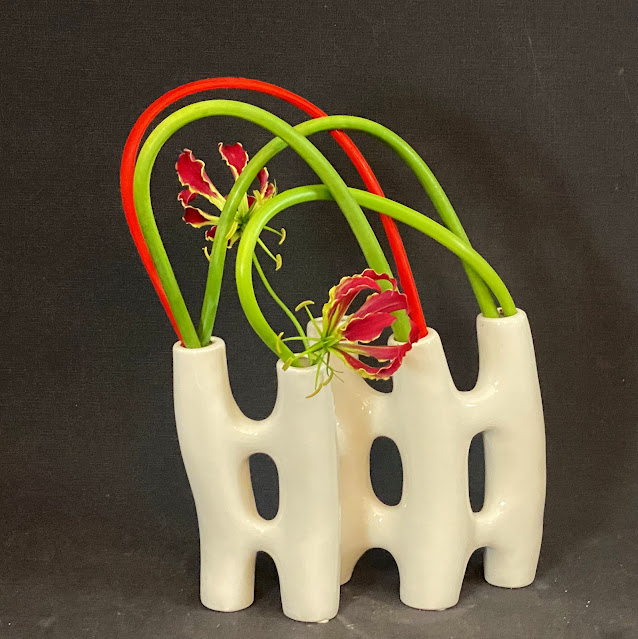Hello all,
Well, the heat has been relentless here in Melbourne the last couple of weeks, which affects not only me but also my garden, Unfortunately, our rain water tanks, which have capacity of 14,500 litres, are both empty and we have to rely on mains water. I have a number of hydrangea shrubs, which require regular watering but, also, protection from the searing sun. Sam and I have been covering them with old sheets, over which I spray water periodically. So far, we've managed to prevent them from cooking. By the way, if you decide to do the same, make sure you use white sheets because the dark ones absorb heat and will do more harm than good.
I've managed to do little gardening jobs in the cooler parts of the day and one of them is the constant battle with the wisteria, which is hell bent on climbing the three trees that grow near it. It had also wound itself very tightly around the cordyline and, in the process of disentangling it, I broke a large piece. Hence the arrangement, above. I removed a great number of the leaves. In fact, if you look closely at the stem, the lighter, upper part was covered with leaves. Having removed the superfluous ones, I was able to create this windswept look. The agapanthus is called Queen Mum and has a tinge of pale blue in the lower part of each individual flower. Sadly, it's not visible in the photo.
Eucalyptus lehmannii, commonly known as bushy yate, is my favourite eucalyptus. There are several, mature trees growing in a rather wide median strip in my area. I just managed to catch them before they were past their best. Of course, any time I try to cut something from along the road (never from people's gardens), some passing motorist feels obliged to toot at me, making me jump out of my skin.
You can be forgiven for thinking that I just placed the stems in the vase but it's not so. It took some trimming and separating the side stems and repositioning them in a more harmonious design. It's a good example of the lesson 'Paying Attention to the Colour of the Container'.
For the first time in, literally, decades, I planted some Cleome Spider Flower seedlings and am now reaping the rewards. I used the first two flowers in a very simple arrangement together with them a lasoo of the errant wisteria.
My Stefanotis is doing particularly well, climbing on the wall next to the balcony. It has a reputation of being a difficult plant but I must have planted it, by fluke, in just the right spot. Its heavily perfumed, pure white flowers frame one side of our balcony, where we've been having our dinners of late. An added bonus is a little bird (species unknown) with a long beak, which comes for the nectar. The plant is also a memento of my colleague, Joan Norbury, who, having heard me say that I like Stefanotis, arrived at my doorstep with a pot of it. The only down side is that the flowers don't last very long in an arrangement. The one, below, barely lasted two days.
With left over umbrella grass stems, I made the arrangement, below. In order to get the jagged lines, I had to wire the stems, which was quite a struggle because they are not tubular and don't allow the wire to penetrate. I used crucifix orchids in two matching, ceramic vases.
Like all gardeners, I too, have my failures. Out of a whole packet of sunflower seeds, I only got three flowers. The one, below, was growing close to the strelitzia nicolai, which had a fresh leaf, just starting to unfurl. So I cut them both and married them together in this next arrangement.
Bye for now,
Emily








































